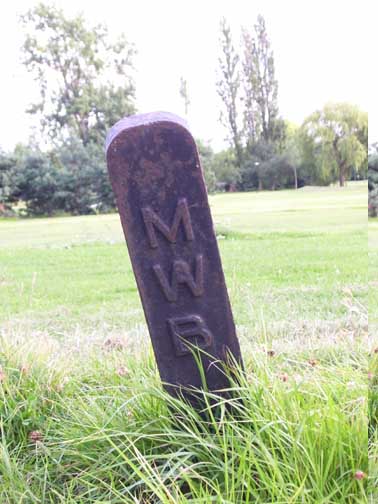 The old Metropolitan Water Board (now Thames Water) trunk-main leaves the London Borough of Barnet at the A5 Cricklewood Broadway. It is traceable briefly, just prior to this, at the point where it emerges from beneath the St. Pancras railway, alongside the railway cottages on the eastern side of the A5.Instinct directs the follower to cross the main road and to proceed down the street opposite, Temple Road. Not only does the street follow more or less in the same direction we have been tracing in our researches so far, but It is also known that there is a large ornate Victorian pumping house at the road’s end, close by Gladstone Park. Yet the street reveals nothing of the watermain intimately conjoined with it. There are none of the familiar indicators, the mushroom-topped gateposts or steel plates with which we identify the presence of the conduit.
The old Metropolitan Water Board (now Thames Water) trunk-main leaves the London Borough of Barnet at the A5 Cricklewood Broadway. It is traceable briefly, just prior to this, at the point where it emerges from beneath the St. Pancras railway, alongside the railway cottages on the eastern side of the A5.Instinct directs the follower to cross the main road and to proceed down the street opposite, Temple Road. Not only does the street follow more or less in the same direction we have been tracing in our researches so far, but It is also known that there is a large ornate Victorian pumping house at the road’s end, close by Gladstone Park. Yet the street reveals nothing of the watermain intimately conjoined with it. There are none of the familiar indicators, the mushroom-topped gateposts or steel plates with which we identify the presence of the conduit.
That is all changed at the end of the road, hard alongside a church with the chimney of the pumping house towering beyond. Here, where Mora Road “T”’s our first street a small length of channelling appears, running through to St Michael’s Road and towards the Thames Water Board’s station. It then runs across the park; a little fenced-in zone adjacent to the railway line that crosses through the park reveals the now familiar Blakeborough irons.
Crossing the bridge over the railway at the park’s south-western corner we enter Mulgrave Road and here, on the right, we see further evidence of the main in an elongated green-space and familiar green railings. This corridor is extended over on the far side of Dudden Road as the main begins to align with the approaching A406.
It is worth a pause here to contemplate the power and reach of this hidden and possibly imagined thing we have attached ourselves to: Starting at Golders Green, we have shifted down off of the gravels and sands of the Hampstead massif into the ditch of the A5 with its impertinent swamp dwellers. This is not so odd – I’ve many-a -time made that little shift myself, in order to secure stocks of cheap foodstuffs or medicine. Next, we passed through Gladstone Park: again, a person living in Golders Green might recourse to a visit to the park to walk the dog or to admire the view of the North Downs available from the old Post Office Telephone Research Station. Most people would drive nowadays, or bicycle, their arses sticking up in defiance as they pass into the cyclists version of interstellar overdrive in order to beat the traffic lurching forwards after being detained a whole fifteen seconds at a traffic light. However some oddballs may still choose to walk. Now, as we approach the moiling traffic of the North Circular we are on the cusp of a new zone - the land beyond the land beyond the land beyond our own zone. And it has been travelled to on foot for reasons beyond the understanding of the average modern town-dweller. I think you will agree that something strange is happening here.
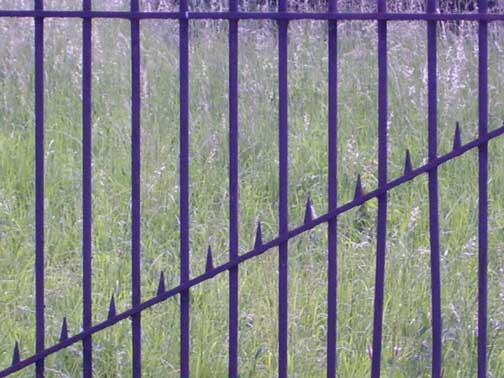
We search hard for indicators of the watermain
As we hit the A406 with its curious tilted camber and its obsolescent food-processing factories, its duck-weed infested feeder, serving the canal, and its supermarkets and furniture warehouses we are moving into hyper-space, readying ourselves for the red-shift to unimagined regions. And through it all, revealing its artefacts, like some long-dead ancient civilisation, runs the force, the tapped medium of Life Itself: Water.
Metropolitan Waterboard water to be exact. Pumped from the Lea, from the Thames at Ditton, up and over the Northern Heights (in either direction) and stored in vast concrete vats at Muswell Hill, West Hampstead, Horsenden Hill, Harrow and many other places. Pumped by electricity and stored so gravity can do the work for us, bringing this substance to our taps with sufficient pressure.
Actually the watermain runs slightly to the south of the A406. It passes under the horseshoe of Great Central Way and beneath Brentfield Road, crossing this to align itself with Meadow Garth and Conduit Way. As the great arch of the Wembley Stadium attempts to draw the eyes up, over the roofs of the houses to the vista beyond we scrutinise the dog-paraded street, looking for signs…
But we do not find them until, crossing Durand Way we enter the forecourt of those dingy office blocks. Here, on a sultry day in July 2005, we were lucky enough to find works in progress. A security man, initially suspicious, warmed to my heart-felt entreaties and showed us the diggings. It was a verification of everything I had supposed for, listening we could here water flowing and removing a piece of corrugated iron we saw the waters rushing below.
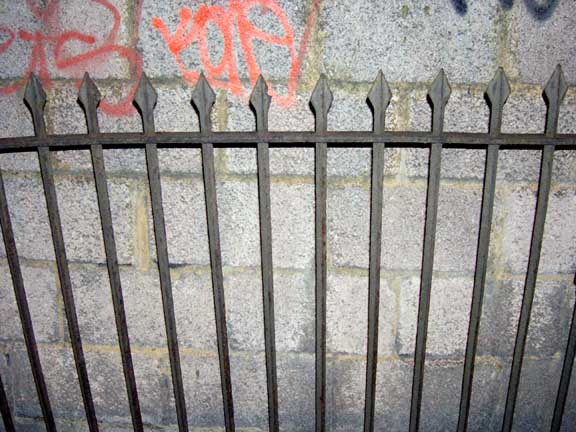
Those hastate palings are a sure sign we''re on the right track
The watermain crosses the A406 here, just by Stonebridge Park, with suggestions of its presence in hastate palings pressed hard up against brick walls on the bridge where the Euston railway is carried over the arterial road on its old arches. We are entering a region of unfamiliar quality. Across the North Circular is a vast man-made plateau holding a hypermarket of some kind. On the north side runs the Brent, and the old route of the A406. Further up is the Ace of Spades café, frequented by bikers and photographed with bewildering frequency by myopic psychogeographers. For myself, I’m onto larger things here so I walk up Beresford Avenue, a street containing classic examples of the “new smokeless manufactories of the South east.” I have projected the route of our watermain and am sure I will find its continuation ahead, somewhere to the left. Sure enough, a brief walk down Wycombe Road brings us to an angled crossing guarded by our friends, the mushroom-topped gateposts. It is our Way, presenting herself in all her glory.
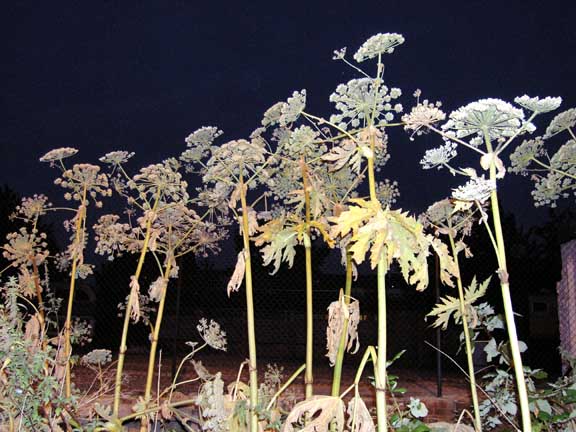
Giant Hogweed lines the watermain at Wycombe Close
Walking back the fifty feet along the designated route of the main we come to some of the giant plates that grant access for those individuals lucky enough to have privy to the Way’s deepest secrets. We can only stand and stare in mute admiration. John Rogers and Peter Knapp accompanied me on my last visit a couple of years back. We found a pile of discarded papers and books and, intent on adding documents to my Deep Library (a composite record of lives lived or endured in the old County of Middlesex) I set to, rummaging in the debris. John, the sod, found a fine 1960s map of New York. I picked out a 1967 Boots desk diary and a notebook of vicious rough-draft letters regarding the break-up of a marriage.
Sample:
I am told you want a devorce well that’s your problem. To much has been said about me how ar you frum your fhotograph you don’t look a day older what have you been takeing for god sake ansour my letter this time remember you are a Bascom and once that’s stoc on you you should never ever give it up
I read this, "stoc" in some dingy little industrial backstreet that night two years back and wondered at the world-lines all tangled, that should bring me and this Bascom together in the city’s awful complexity of lives and intersections. And drilling through it all, a persistent presence below the eras and ages, the haircuts and trousers (flared or drainpiped) and our silly obsessions and fashions, runs the Way.
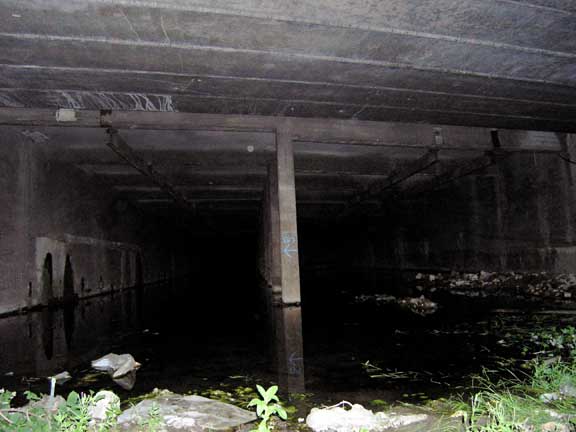
The black maw spoke of abrupt endings
Turning back we moved ahead to where the Way will pass beneath the canal. Our route was brought to an end at this stage by a cement building, a carpark or some such. This was really the End, for, looking into the open-fronted space forming the underbelly of the building we saw a vast lake stretching into darkness, a black sheet of water suggestive of arrivals at places long avoided; of abrupt terminations and the glugging maw waiting, all wet and patient, to reclaim us.
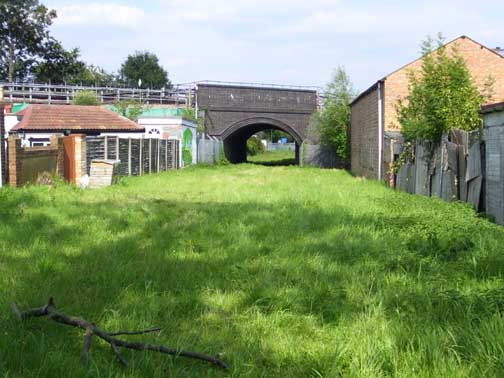
On towards Perivale...

